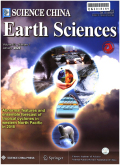- 钛学术文献服务平台 \
- 学术期刊 \
- 基础科学期刊 \
- 自然科学总论期刊 \
- 中国科学:地球科学(英文版)期刊 \
Accretionary complex:Geological records from oceanic subduction to continental deep subduction
Accretionary complex:Geological records from oceanic subduction to continental deep subduction
基本信息来源于合作网站,原文需代理用户跳转至来源网站获取
摘要:
Accretionary complex was usually formed by offscraping of the subducting crustal material over the trench and thus often referred to as subduction zone melange.The structure,composition and forming process of accretionary wedges can provide important insights into the evolution history of ocean basin,ocean-continent material cycle,continental accretion and thus contribute to understanding of the origin of plates and the growth of continents.Accretionary complex is characterized by a block-in-matrix structure associated with imbricate thrusts and isoclinal folds,diversified metamorphic types and intense water-rock interactions,which are distinct to the traditional stratigraphy.Since the proposal of the concept of accretionary wedge over a hundred years ago,great progress has been made in a variety of research focuses,such as the identification of the distribution of accretionary complexes,their compositions and formation mechanisms,the affinities of the matrix and igneous rocks,the recognition of the Ocean Plate Stratigraphy(OPS),the reconstruction of oceanic basin,the dynamic background of the tectonic evolution,the relationship between subduction zone and orogenic belt and,in particular,the accretionary complexes in con-tinental subduction zones.These studies have significantly improved our understanding of the plate tectonic theory.Challenges remain in the identification of ancient accretionary complexes,the detailed analysis of accretionary complex zones,the accretion characteristics during continental collision,and the geochemical tracing of water-rock interaction during the accretion.China contains representative orogenic belts and accretionary complex zones in the world,and its geological records provide the best opportunity to make new breakthroughs in understanding of the plate tectonics.

推荐文章
Major Miocene geological events in southern Tibet and eastern Asia induced by the subduction of the
Ridge subduction
Eastern Tibetan Plateau
Cenozoic mineralization
Seismic anomaly
Geological cycling of potassium and the K isotopic response: insights from loess and shales
K isotopes
Loess
Shale
K cycle
Lithium elemental and isotopic disequilibrium in minerals from peridotite xenoliths from Shangzhi, N
Mantle peridotite
Li isotope
Mantle metasomatism
Northeastern China
内容分析
关键词云
关键词热度
相关文献总数
(/次)
(/年)
文献信息
| 篇名 | Accretionary complex:Geological records from oceanic subduction to continental deep subduction | ||
| 来源期刊 | 中国科学:地球科学(英文版) | 学科 | |
| 关键词 | |||
| 年,卷(期) | 2020,(12) | 所属期刊栏目 | REVIEW |
| 研究方向 | 页码范围 | 1868-1883 | |
| 页数 | 16页 | 分类号 | |
| 字数 | 语种 | 英文 | |
| DOI | |||
五维指标
引文网络
引文网络
二级参考文献 (885)
共引文献 (288)
参考文献 (82)
节点文献
引证文献 (0)
同被引文献 (0)
二级引证文献 (0)
1912(1)
- 参考文献(0)
- 二级参考文献(1)
1947(1)
- 参考文献(0)
- 二级参考文献(1)
1950(1)
- 参考文献(1)
- 二级参考文献(0)
1960(1)
- 参考文献(0)
- 二级参考文献(1)
1961(1)
- 参考文献(0)
- 二级参考文献(1)
1962(1)
- 参考文献(0)
- 二级参考文献(1)
1963(1)
- 参考文献(0)
- 二级参考文献(1)
1964(4)
- 参考文献(0)
- 二级参考文献(4)
1965(1)
- 参考文献(0)
- 二级参考文献(1)
1967(1)
- 参考文献(0)
- 二级参考文献(1)
1968(2)
- 参考文献(0)
- 二级参考文献(2)
1969(1)
- 参考文献(0)
- 二级参考文献(1)
1970(2)
- 参考文献(0)
- 二级参考文献(2)
1971(1)
- 参考文献(0)
- 二级参考文献(1)
1972(1)
- 参考文献(0)
- 二级参考文献(1)
1973(3)
- 参考文献(0)
- 二级参考文献(3)
1975(6)
- 参考文献(1)
- 二级参考文献(5)
1976(1)
- 参考文献(0)
- 二级参考文献(1)
1977(3)
- 参考文献(0)
- 二级参考文献(3)
1978(1)
- 参考文献(1)
- 二级参考文献(0)
1979(2)
- 参考文献(0)
- 二级参考文献(2)
1980(2)
- 参考文献(0)
- 二级参考文献(2)
1981(2)
- 参考文献(0)
- 二级参考文献(2)
1982(7)
- 参考文献(1)
- 二级参考文献(6)
1983(6)
- 参考文献(2)
- 二级参考文献(4)
1984(4)
- 参考文献(0)
- 二级参考文献(4)
1985(4)
- 参考文献(0)
- 二级参考文献(4)
1986(11)
- 参考文献(1)
- 二级参考文献(10)
1987(3)
- 参考文献(0)
- 二级参考文献(3)
1988(11)
- 参考文献(0)
- 二级参考文献(11)
1989(14)
- 参考文献(3)
- 二级参考文献(11)
1990(10)
- 参考文献(2)
- 二级参考文献(8)
1991(10)
- 参考文献(1)
- 二级参考文献(9)
1992(11)
- 参考文献(3)
- 二级参考文献(8)
1993(22)
- 参考文献(1)
- 二级参考文献(21)
1994(11)
- 参考文献(0)
- 二级参考文献(11)
1995(17)
- 参考文献(0)
- 二级参考文献(17)
1996(23)
- 参考文献(1)
- 二级参考文献(22)
1997(23)
- 参考文献(0)
- 二级参考文献(23)
1998(21)
- 参考文献(1)
- 二级参考文献(20)
1999(35)
- 参考文献(2)
- 二级参考文献(33)
2000(26)
- 参考文献(4)
- 二级参考文献(22)
2001(25)
- 参考文献(2)
- 二级参考文献(23)
2002(19)
- 参考文献(1)
- 二级参考文献(18)
2003(23)
- 参考文献(3)
- 二级参考文献(20)
2004(30)
- 参考文献(5)
- 二级参考文献(25)
2005(37)
- 参考文献(3)
- 二级参考文献(34)
2006(29)
- 参考文献(1)
- 二级参考文献(28)
2007(35)
- 参考文献(3)
- 二级参考文献(32)
2008(32)
- 参考文献(4)
- 二级参考文献(28)
2009(57)
- 参考文献(3)
- 二级参考文献(54)
2010(41)
- 参考文献(1)
- 二级参考文献(40)
2011(56)
- 参考文献(3)
- 二级参考文献(53)
2012(53)
- 参考文献(4)
- 二级参考文献(49)
2013(54)
- 参考文献(5)
- 二级参考文献(49)
2014(35)
- 参考文献(1)
- 二级参考文献(34)
2015(54)
- 参考文献(2)
- 二级参考文献(52)
2016(27)
- 参考文献(3)
- 二级参考文献(24)
2017(31)
- 参考文献(4)
- 二级参考文献(27)
2018(13)
- 参考文献(2)
- 二级参考文献(11)
2019(5)
- 参考文献(5)
- 二级参考文献(0)
2020(2)
- 参考文献(2)
- 二级参考文献(0)
2020(2)
- 参考文献(2)
- 二级参考文献(0)
- 引证文献(0)
- 二级引证文献(0)
引文网络交叉学科
相关学者/机构
期刊影响力
中国科学:地球科学(英文版)
主办单位:
中国科学院
出版周期:
月刊
ISSN:
1674-7313
CN:
11-5843/P
开本:
16开
出版地:
北京东黄城根北街16号
邮发代号:
创刊时间:
1996
语种:
eng
出版文献量(篇)
3812
总下载数(次)
0
总被引数(次)
30396
期刊文献
相关文献
推荐文献
- 期刊分类
- 期刊(年)
- 期刊(期)
- 期刊推荐
力学
化学
地球物理学
地质学
基础科学综合
大学学报
天文学
天文学、地球科学
数学
气象学
海洋学
物理学
生物学
生物科学
自然地理学和测绘学
自然科学总论
自然科学理论与方法
资源科学
非线性科学与系统科学
中国科学:地球科学(英文版)2022
中国科学:地球科学(英文版)2021
中国科学:地球科学(英文版)2020
中国科学:地球科学(英文版)2019
中国科学:地球科学(英文版)2018
中国科学:地球科学(英文版)2017
中国科学:地球科学(英文版)2016
中国科学:地球科学(英文版)2015
中国科学:地球科学(英文版)2014
中国科学:地球科学(英文版)2013
中国科学:地球科学(英文版)2012
中国科学:地球科学(英文版)2011
中国科学:地球科学(英文版)2010
中国科学:地球科学(英文版)2009
中国科学:地球科学(英文版)2008
中国科学:地球科学(英文版)2007
中国科学:地球科学(英文版)2006
中国科学:地球科学(英文版)2005
中国科学:地球科学(英文版)2004
中国科学:地球科学(英文版)2003
中国科学:地球科学(英文版)2002
中国科学:地球科学(英文版)2001
中国科学:地球科学(英文版)2000
中国科学:地球科学(英文版)2020年第9期
中国科学:地球科学(英文版)2020年第8期
中国科学:地球科学(英文版)2020年第7期
中国科学:地球科学(英文版)2020年第6期
中国科学:地球科学(英文版)2020年第5期
中国科学:地球科学(英文版)2020年第4期
中国科学:地球科学(英文版)2020年第3期
中国科学:地球科学(英文版)2020年第2期
中国科学:地球科学(英文版)2020年第12期
中国科学:地球科学(英文版)2020年第11期
中国科学:地球科学(英文版)2020年第10期
中国科学:地球科学(英文版)2020年第1期

 免费查重
免费查重










